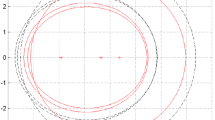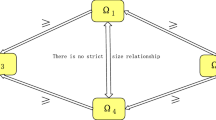Abstract
A new upper bound for the infinity norm of inverse matrix of a strictly diagonally dominant M-matrix is given, and the lower bound for the minimum eigenvalue of the matrix is obtained. Furthermore, an upper bound for the infinity norm of inverse matrix of a strictly α-diagonally dominant M-matrix is presented. Finally, we give numerical examples to illustrate our results.
Similar content being viewed by others
1 Introduction
Let \(R^{n\times n}\) denote the set of all \(n\times n\) real matrices, \(N=\{1, 2, \ldots, n\}\) and \(A=(a_{ij})\in R^{n\times n}\) (\(n\geq2\)). A matrix A is called a nonsingular M-matrix if there exist a nonnegative matrix B and some real number s such that
where I is the identity matrix, \(\rho(B)\) is the spectral radius of B. \(\tau(A)\) denotes the minimum of all real eigenvalues of the nonsingular M-matrix A.
Very often in numerical analysis, one needs a bound for the condition number of a square \(n\times n\) matrix A, \(\operatorname{Cond}(A)=\|A\|_{\infty}\cdot\|A^{-1}\|_{\infty}\). Bounding \(\|A\|_{\infty}\) is not usually difficult, but a bound of \(\|A^{-1}\|_{\infty}\) is not usually available unless \(A^{-1}\) is known explicitly.
However, if \(A=(a_{ij})\in R^{n\times n}\) is a strictly diagonally dominant matrix, Varah [1] bound \(\|A^{-1}\|_{\infty}\) quite easily by the following result:
Remark 1
[2]
If the diagonal dominance of A is weak, i.e., \(\min_{i\in N} \{|a_{ii}|-\sum_{j\neq i}|a_{ij}| \}\) is small, then using (1) in estimating \(\|A^{-1}\|_{\infty}\), the bound may yield a large value.
In 2007, Cheng and Huang [2] presented the following results.
If \(A=(a_{ij})\) is a strictly diagonally dominant M-matrix, then
If \(A=(a_{ij})\) is a strictly diagonally dominant M-matrix, then the bound in (2) is sharper than that in Theorem 3.3 in [3], i.e.,
In 2009, Wang [4] obtained the better result: Let \(A=(a_{ij})\) be a strictly diagonally dominant M-matrix. Then
In this paper, we present new upper bounds for \(\|A^{-1}\|_{\infty}\) of a strictly (α-)diagonally dominant M-matrix A, which improved the above results. As an application, a lower bound of \(\tau(A)\) is obtained.
For convenience, for \(i,j,k \in N\), \(j\neq i\), denote
We will denote by \(A^{(n_{1},n_{2})}\) the principal submatrix of A formed from all rows and all columns with indices between \(n_{1}\) and \(n_{2}\) inclusively; e.g., \(A^{(2,n)}\) is the submatrix of A obtained by deleting the first row and the first column of A.
Definition 1
[3]
\(A=(a_{ij})\in R^{n\times n}\) is a weakly chained diagonally dominant if for all \(i\in N\), \(d_{i}\leq1\) and \(J(A)\neq\phi\), and for all \(i\in N\), \(i\notin J(A)\), there exist indices \(i_{1}, i_{2},\ldots,i_{k}\) in N with \(a_{i_{r},i_{r+1}}\neq0\), \(0\leq r\leq k-1\), where \(i_{0}=i\) and \(i_{k}\in J(A)\).
Definition 2
[5]
\(A=(a_{ij})\in R^{n\times n}\) is called a strictly α-diagonally dominant matrix if there exists \(\alpha\in[0,1]\) such that
2 Upper bounds for \(\|A^{-1}\|_{\infty}\) of a strictly diagonally dominant M-matrix
In this section, we give several bounds of \(\|A^{-1}\|_{\infty}\) and \(\tau(A)\) for a strictly diagonally dominant M-matrix A.
Lemma 1
[2]
Let \(A=(a_{ij})\) be a weakly chained diagonally dominant M-matrix, \(B=A^{(2,n)}\), \(A^{-1}=(\alpha_{ij})\), and \(B^{-1}=(\beta_{ij})\). Then, for \(i,j=2,\ldots,n\),
Furthermore, if \(J(A)=N\), then
Lemma 2
[2]
If \(A=(a_{ij})\) is a strictly diagonally dominant M-matrix, then
Lemma 3
Let \(A=(a_{ij})\) be a strictly diagonally dominant M-matrix. Then, for \(A^{-1}=(\alpha_{ij})\),
Proof
This proof is similar to the one of Lemma 2 in [6]. □
Lemma 4
Let \(A=(a_{ij})\) be a strictly diagonally dominant M-matrix. Then, for \(A^{-1}=(\alpha_{ij})\),
Proof
This proof is similar to the one of Lemma 2.3 in [7]. □
Lemma 5
[3]
Let \(A=(a_{ij})\) be a weakly chained diagonally dominant M-matrix, \(A^{-1}=(\alpha_{ij})\), and \(\tau=\tau(A)\). Then
where
Theorem 1
Let \(A=(a_{ij})\) be a strictly diagonally dominant M-matrix, \(B=A^{(2,n)}\), \(A^{-1}=(\alpha_{ij})\), and \(B^{-1}=(\beta_{ij})\). Then
Proof
Let
Then
By Lemma 1, Lemma 2, and Lemma 4,
Let \(2\leq i\leq n\). Then, by Lemma 1 and Lemma 3,
Therefore, for \(2\leq i\leq n\), we have
Furthermore, from (4) and (5), we obtain
The result follows. □
Theorem 2
Let \(A=(a_{ij})\) be a strictly diagonally dominant M-matrix. Then
Proof
The result follows by applying the principle of mathematical induction with respect to k on \(A^{(k,n)}\) in (6). □
By Lemma 5 and Theorem 1, we can obtain a new bound of \(\tau(A)\).
Corollary 1
If \(A=(a_{ij})\) is a strictly diagonally dominant M-matrix, then
Theorem 3
Let \(A=(a_{ij})\) be a strictly diagonally dominant M-matrix. Then the bound in (7) is better than that in (3), i.e.,
Proof
Since A is a strictly diagonally dominant matrix, so \(0\leq u_{j}\), \(l_{j}<1\) for all j. By the definition of \(u_{i}\), \(l_{i}\), \(\omega_{ki}\), we have \(\omega_{ki}\leq l_{i}\) and \(a_{ii}u_{i}=\sum_{k=i+1}^{n}|a_{ik}|\) for all i. Obviously, the result follows. □
3 Upper bounds for \(\|A^{-1}\|_{\infty}\) of a strictly α-diagonally dominant M-matrix
In this section, we present an upper bound of \(\|A^{-1}\|_{\infty}\) for a strictly α-diagonally dominant M-matrix A.
Lemma 6
[8]
Let \(A, B\in R^{n\times n}\). If A and \(A-B\) are nonsingular, then
Lemma 7
Let \(A=(a_{ij})\in R^{n\times n}\) be a strictly diagonally dominant M-matrix, and \(B=(b_{ij}) \in R^{n\times n}\). If \(\varphi_{0} \cdot \|B\|_{\infty}<1\), then \(\|A^{-1}B\|_{\infty}<1\), where
Proof
By Theorem 2, we get
The result follows. □
Lemma 8
[8]
If \(\|A^{-1}\|_{\infty}<1\), then \(I-A\) is nonsingular and
Theorem 4
Let \(A=(a_{ij})\in R^{n\times n}\) be a strictly α-diagonally dominant matrix, \(\alpha\in(0, 1]\) and A be an M-matrix. If \(\{ i\in N| R_{i}(A)>C_{i}(A) \}\neq\emptyset\), and
then
where
Proof
Let \(A=B-C\), where \(B=(b_{ij})\), \(C=(c_{ij})\), and
For any \(i\in\{ i\in N| R_{i}(A)>C_{i}(A)\}\), we get
For any \(i\in\{ i\in N| R_{i}(A)\leq C_{i}(A)\}\), we have
Thus, B is a strictly diagonal dominant M-matrix. By Lemma 7, we get \(\|B^{-1}C\|_{\infty}<1\). By Lemma 6, Lemma 8, and Theorem 2, we have
Therefore
Furthermore, we have
The result follows. □
4 Numerical examples
In this section, we present numerical examples to illustrate the advantages of our derived results.
Example 1
Let
It is easy to see that A is a strictly diagonally dominant M-matrix. By calculations with Matlab 7.1, we have
respectively. It is obvious that the bound in (7) is the best result.
Example 2
Let
It is easy to see that A is a strictly α-diagonally dominant M-matrix by taking \(\alpha=0.5\), and A is not a strictly diagonally dominant matrix. Thus the bound of \(\|A^{-1}\|_{\infty}\) cannot be estimated by (1), (2), and (3), but it can be estimated by (8). By (8), we get
References
Varah, JM: A lower bound for the smallest singular value of a matrix. Linear Algebra Appl. 11, 3-5 (1975)
Cheng, GH, Huang, TZ: An upper bound for ∥A −1∥∞ of strictly diagonally dominant M-matrices. Linear Algebra Appl. 426, 667-673 (2007)
Shivakumar, PN, Williams, JJ, Ye, Q, Marinov, CA: On two-sided bounds related to weakly diagonally dominant M-matrices with application to digital circuit dynamics. SIAM J. Matrix Anal. Appl. 17, 298-312 (1996)
Wang, P: An upper bound for ∥A −1∥∞ of strictly diagonally dominant M-matrices. Linear Algebra Appl. 431, 511-517 (2009)
Zhang, YL, Mo, HM, Liu, JZ: α-Diagonal dominance and criteria for generalized strictly diagonally dominant matrices. Numer. Math. 31, 119-128 (2009)
Li, YT, Wang, F, Li, CQ, Zhao, JX: Some new bounds for the minimum eigenvalue of the Hadamard product of an M-matrix and an inverse M-matrix. J. Inequal. Appl. 2013, 480 (2013)
Li, YT, Chen, FB, Wang, DF: New lower bounds on eigenvalue of the Hadamard product of an M-matrix and its inverse. Linear Algebra Appl. 430, 1423-1431 (2009)
Xu, S: Theory and Methods about Matrix Computation. Tsinghua University Press, Beijing (1986)
Acknowledgements
This work was supported by the National Natural Science Foundation of China (11361074, 71161020) and IRTSTYN, Applied Basic Research Programs of Science and Technology Department of Yunnan Province (2013FD002).
Author information
Authors and Affiliations
Corresponding author
Additional information
Competing interests
The authors declare that they have no competing interests.
Authors’ contributions
The authors contributed equally to this work. All authors read and approved the final manuscript.
Rights and permissions
Open Access This article is distributed under the terms of the Creative Commons Attribution 4.0 International License (http://creativecommons.org/licenses/by/4.0/), which permits unrestricted use, distribution, and reproduction in any medium, provided you give appropriate credit to the original author(s) and the source, provide a link to the Creative Commons license, and indicate if changes were made.
About this article
Cite this article
Wang, F., Sun, Ds. & Zhao, Jx. New upper bounds for \(\|A^{-1}\|_{\infty}\) of strictly diagonally dominant M-matrices. J Inequal Appl 2015, 172 (2015). https://doi.org/10.1186/s13660-015-0696-2
Received:
Accepted:
Published:
DOI: https://doi.org/10.1186/s13660-015-0696-2




